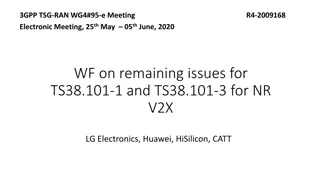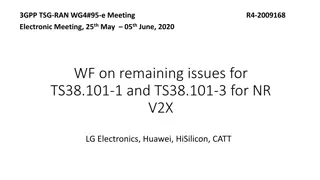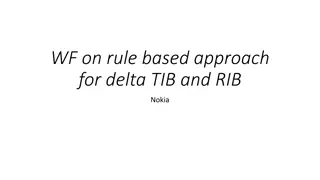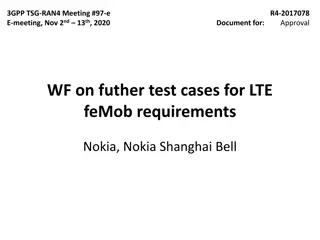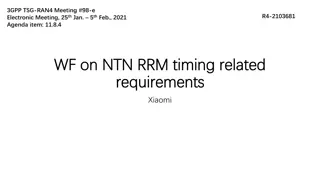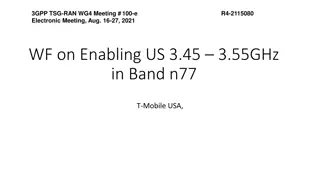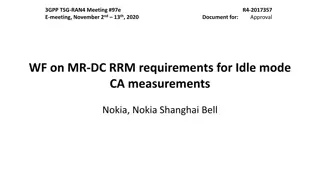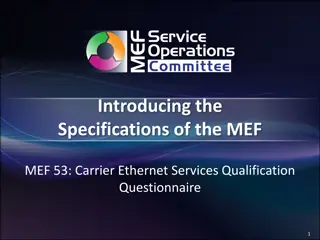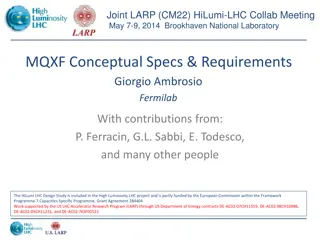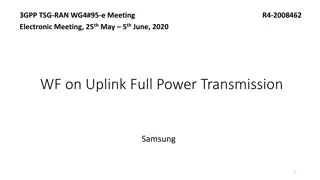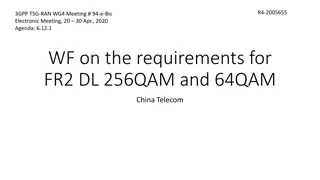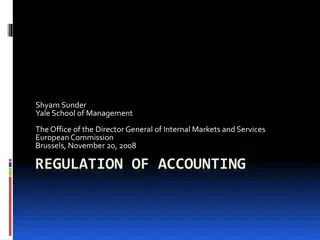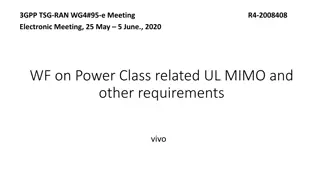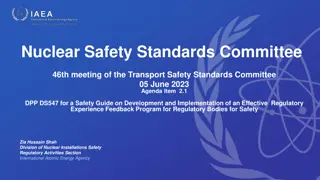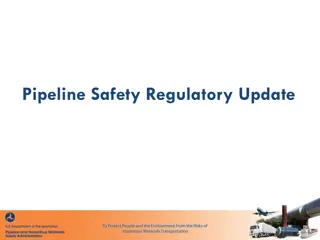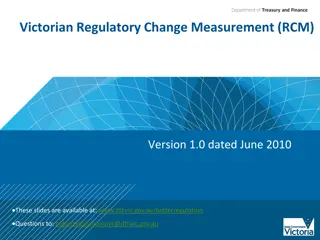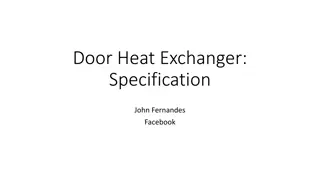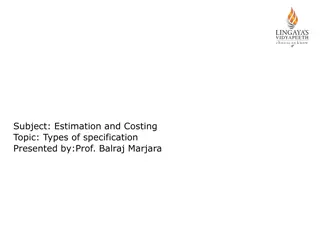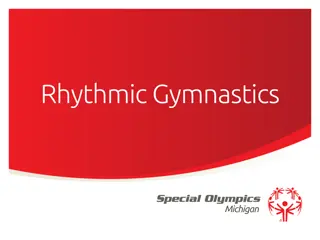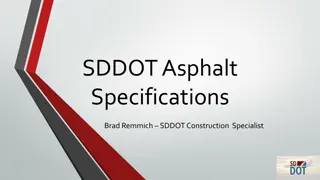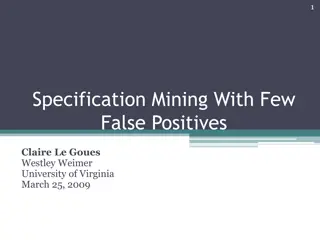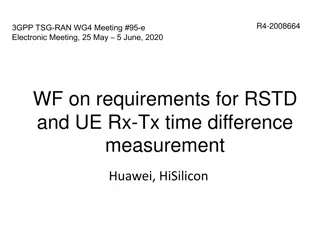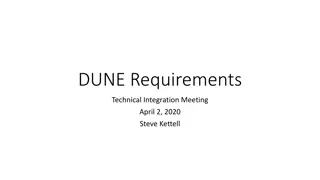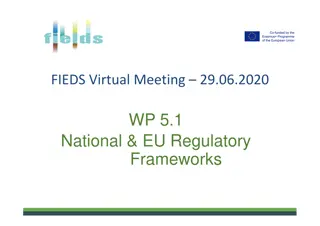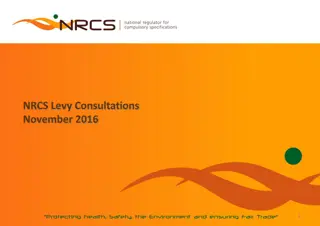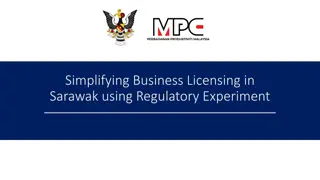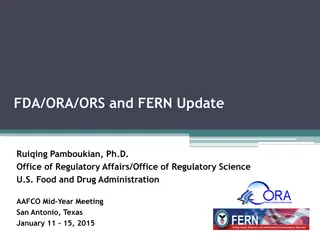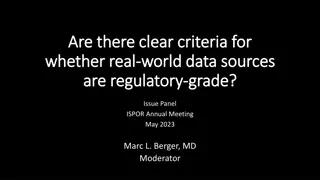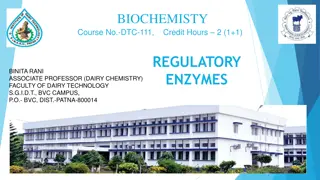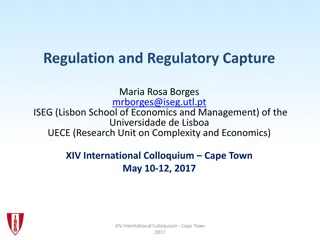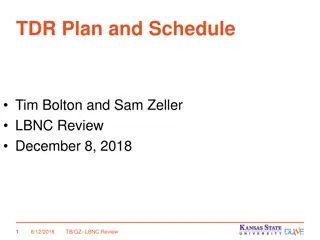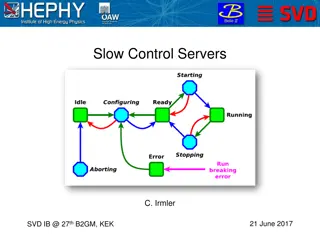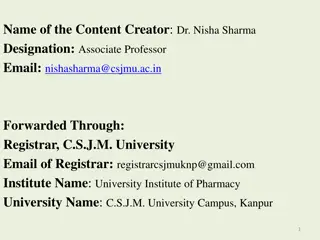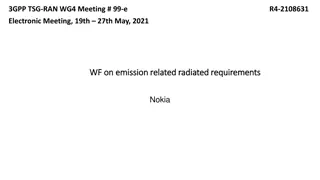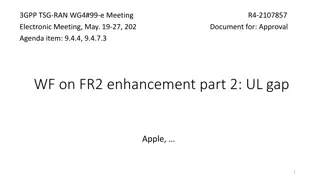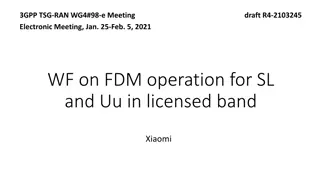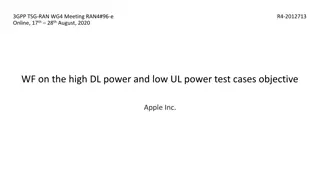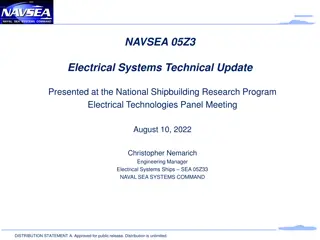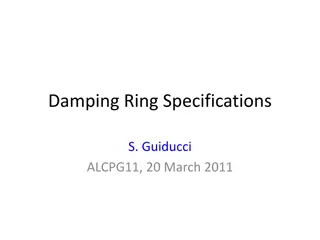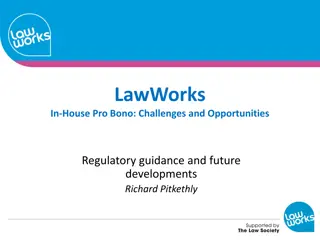Regulatory Requirements in TS38.101-2 and Impact on RAN4 Specifications
Common understanding of the regulatory requirements outlined in TS38.101-2 for bands n258, n257, n260, and n259, including issues related to NS values, A-MPR, connectivity, and transitional periods. Agreements and solutions discussed in RAN4#94-e-bis meeting to address NS mapping, A-MPR issues, and implementation of new NS values. Package agreements on handling newly supported NS values and addressing emissions limits for UE compatibility.
Download Presentation

Please find below an Image/Link to download the presentation.
The content on the website is provided AS IS for your information and personal use only. It may not be sold, licensed, or shared on other websites without obtaining consent from the author. Download presentation by click this link. If you encounter any issues during the download, it is possible that the publisher has removed the file from their server.
E N D
Presentation Transcript
3GPP TSG-RAN WG4 Meeting #95-e Online Meeting, 25 May - 5 June 2020 R4-2008410 [draft] WF on WRC-19 outcome and impact on RAN4 specifications NTT DOCOMO, INC.
Background (1/3) Common understanding of which regulatory requirements TS38.101-2 should address (for information only): Note: Necessity of -8dBm/200MHz is FFS. Note: Some must be met simultaneously like 1/2/4 and 1/3/4 for Europe. Region3/ Requirement 1 Requirement 2 Requirement 3 Requirement 4 Requirement 5 Requirement 6 Global, US, Japan Protected range: 23.6 - 24.0 GHz Protected range: 23.6 - 24.0 GHz N/A Protected range: spurious Protected range: 36.0 to 37.0 GHz Protected range: 36.0 to 37.0 GHz Band applicability: n258, n257 Band applicability: n258, n257 Band applicability: all Band applicability: n260, n259 Band applicability: n260, n259 Protected range: 7.25 GHz f 2nd harmonic Europe Limit: +1 dBm/200 MHz Limit: -5 dBm/200 MHz Limit: -13 dBm/MHz Limit: +7 dBm/1000 MHz Limit: -13 dBm/1 MHz Band applicability: all bands Limit: -10 dBm/100 MHz
Background (2/3) To introduce the regulatory requirements in TS 38.101-2, the following issues have been discussed. Connectivity issues when adding new NS values to existing bands [1][2][3] Handling of regulation to change from a loose limit to stringent one with transition period [3] Invoked larger A-MPR from the changeover date Allows UEs violating regulation to work if the NS value for stringent one is optional support NS value mapping and A-MPR issues [3]
Background (3/3) Agreements from WF [3] in RAN4#94-e-bis (This is an extract, the details are described in [3]) The followings are package agreements. How to resolve the issues identified in the background slides NS mapping and associated A-MPR After the process on how to resolve the newly introduced NS issues and NS mapping is agreed, each band will be handled independently without waiting for the completion of the other bands. A feature for a UE to report newly supported NS value(s) for a legacy band to a network is introduced. Four Alts are listed. Alt 1-1: Explicit signaling for a UE to report newly supported NS value(s) for a legacy band to the network (introduce a new signaling feature) Alt 1-2: Explicit signaling for a UE to report newly supported NS value(s) for a legacy band to the network (reuse modifiedMPR bits) Alt 1-3: Explicit signaling for a UE to report newly supported NS value(s) for a legacy band to the network, such that supporting of NS values is optional Alt 2: Delay introduction of new NS until beginning of Rel-X, such that it is mandatory for a UE designed against Rel-X to support all NS values defined in the Rel-X version of the specification and which correspond to the bands which the UE supports. For NS mapping and A-MPR, Adopt one of the two (Option 1 or 2 in [3]) based on necessity of -8dBm/200MHz. +1dBm/200MHz for n257 & 7dBm/1GHz for n259 are introduced into NS_200, respectively, at least if no A- MPR is needed. The same mapping for single CC is applied to that for CA. A note is added to NS values for changed emissions limits (example shown: -5dBm/200MHz after 1st Sep 2027 in [3])
Option 1: -8dBm/200MHz stays Note: n261 is omitted since the band has no connection with lower/upper EESS protection. n257 n258 n259 n260 1dBm/200MHz into general No change 7dBm/1GHz into general No change NS_200 -8dBm/200MHz + -10dBm/100MHz -8dBm/200MHz + -10dBm/100MHz NS_201 -10dBm/100MHz + 1dBm/200MHz -10dBm/100MHz + 1dBm/200MHz NS_202 1dBm/200MHz NS_203 -5dBm/200MHz -5dBm/200MHz NS_204 7dBm/1GHz + -13dBm/MHz NS_205 -5dBm/200MHz + -10dBm/100MHz -5dBm/200MHz + -10dBm/100MHz NS_206
Option 2: -8dBm/200MHz isnt necessary Note: n261 is omitted since the band has no connection with lower/upper EESS protection. n257 n258 n259 n260 1dBm/200MHz into general No change 7dBm/1GHz into general No change NS_200 FFS FFS NS_201 -10dBm/100MHz + 1dBm/200MHz -10dBm/100MHz + 1dBm/200MHz NS_202 1dBm/200MHz NS_203 -5dBm/200MHz -5dBm/200MHz NS_204 7dBm/1GHz + -13dBm/MHz NS_205
WF 1 Take Option 2 and Alt 1-2(Need to discuss) from [3] as package agreements -8dBm/200MHz requirements is not needed and will be removed NS_202 includes harmonic requirements (Requirement 4) and +1 dBm/200 MHz (Requirement 2) Take A-MPR values proposed in [4]WF3 Author s note: There is no objection in 1stround, but one company need further check in 2ndround +1dBm/200MHz for n257 & 7dBm/1GHz for n259 are introduced into NS_200, respectively, according to the previous agreements. Newly introduced NS is mandatory for UE brought into use at least after the changeover date Whether NS_201 can be repurposed to signal the -5dBm/200MHz requirement is FFS Whether mandatory or not for UE brought into use before the changeover date is FFS FFS how to avoid mandating UEs to meet NS_204 before it is required in regulations, e.g. until 2024 in EU and 2027 in JP/US. FFS if mandatory status of NS is tied to release version NOTE: This WF is applicable to WRC-19 requirements.
WF 2 For handling of NS_201, whether repurposing NS_201 is FFS If repurpose NS_201, the following should be discussed Whether modified MPR for NS_201 is needed or not is FFS (Need to discuss) The descriptive Text in CR [5] should be same with that in CR [6] (It depends on whether alt 1-2 will be taken which alts we choose) If not repurpose NS_201, the following should be discussed Whether or not NS_201 is obsolete is FFS (Need to discuss)
WF3: A-MPR values Requirement A-MPR for PC1 Band A-MPR for PC2 A-MPR for PC3 A-MPR for PC4 3.0 if Offset frequency < BWchannel, 0.0 otherwise 0 (absorb as general requirement) Protected range: 23.6 - 24.0 GHz Limit: +1 dBm/200 MHz n258 0 0 0 0 (absorb as general requirement) 0 (absorb as general requirement) 0 (absorb as general requirement) n257 n258 Protected range: 23.6 - 24.0 GHz Limit: -5 dBm/200 MHz 7.0 if Offset frequency < BWchannel, 6.0 otherwise 1.0 if Offset frequency < BWchannel, 0.0 otherwise 1.0 if Offset frequency < BWchannel, 0.0 otherwise 1.0 if Offset frequency < BWchannel, 0.0 otherwise n257 Protected range: 36.0 to 37.0 GHz Limit: +7 dBm/1000 MHz and -13 dBm/1 MHz >0 for low edge allocations (see below) >0 for low edge allocations (see below) >0 for low edge allocations (see below) >0 for low edge allocations (see below) n260 0 (absorb as general requirement) 0 (absorb as general requirement) 0 (absorb as general requirement) 0 (absorb as general requirement) n259 NOTE: see R4-2006788 [4] for definitions of offset frequency and edge allocation
References [1] R4-2000220, Necessity of signaling supported NS values , NTT DOCOMO, INC. [2] R4-2003241, More on necessity of signaling supported NS values , NTT DOCOMO, INC., KDDI Corporation, SoftBank Corp., [3] R4-2005738, WF on WRC-19 outcome and impact on RAN4 specifications , NTT DOCOMO, INC. [4] R4-2006788, dCR to 38.101-2: Introduction of NS flags and A-MPR from WRC19 Resolutions , Qualcomm Incorporated [5] R4-2008163, CR for modified MPR on NS_201 , Huawei, HiSilicon [6] R4-2007038, Introduction of the Annex modifiedMPR-Behaviour into the NR SA specification , Ericsson


